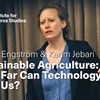seat
A Future of Expulsions
Main speaker: Saskia Sassen Today’s socioeconomic and environmental dislocations cannot be fully understood in the usual terms of poverty and injustice, but more accurately in terms of expulsion—from p
Making sense of corruption
Corruption is a serious threat to prosperity, democracy and well-being, with mounting empirical evidence highlighting it detrimental effects on society. Yet defining this threat has resulted in profou
Completed: Mission: Artistic Director
This project considers artistic leadership and managerial skills in Swedish theatre, a subject which has been debated both publicly and internally the past few years.
The Future of Humans: Moral Bioenhancement
Main speaker: Julian Savulescu, Uehiro Professor of Practical Ethics A seminar on the use of medicine to improve moral behaviour and solve the greatest problems of the 21st century. The greatest problem
Climate change and affective conflicts
Sweden has just experienced some unusually warm weeks in June. In Spain, yet another heat wave is causing alarm. In a text published in the Spanish newspaper El País, philosopher Julia Mosquera descri
Communication activity in social networks: growth and correlations
2011. European Physical Journal B 84:147-159. AbstractWe investigate the timing of messages sent in two online communities with respect to growth fluctuations and long-term correlations. We find that the
Frukostseminarium: Kan man planera för framtiden?
De senaste decennierna har flera politiskt tillsatta framtidskommissioner och utredningar sett dagens ljus för att snart falla i glömska eller drunkna i allt som redan händer här och nu. Men vilka behoVi har bjudit in Katarina Engberg, fil. dr. i Freds- och konfliktforskning samt tidigare departementsråd i Regeringskansliet, att berätta om sin erfarenhet av strategisk planering i Statsrådsberedningen (Kansliet för strategi- och framtidsfrågor och EU-kansliet), Försvarsdepartementet och Försvarsmakten. Tid: Torsdag, 15 februari 08.30–10.00 med enklare frukost från kl. 08.00Plats: Institutet för Framtidsstudier, Holländargatan 13 i Stockholm

Karim Jebari & Emma Engström: Sustainable Agriculture - How Far Can Technology Take Us?
What would it take to have a sustainable world by the year 2100? In their research, philosopher Karim Jebari, and Emma Engström, PhD in technology, have analyzed a large set of potentially disruptive
Applying spatial regression to evaluate risk factors for microbiological contamination of urban groundwater sources in Juba, South Sudan
Hydrogeology Journal 25(4) pp. 1077-1091, doi: 10.1007/s10040-016-1504-x Abstract This study developed methodology for statistically assessing groundwater contamination mechanisms. It focused on microbiahumanitarian aid organisation Médecins Sans Frontières in 2010. The factors included hydrogeological settings, land use and socio-economic characteristics. The results showed that the residuals of a conventional probit regression model had a significant positive spatial autocorrelation (Moran’s I =3.05, I-stat = 9.28); therefore, a spatial model was developed that had better goodness-of-fit to the observations. The mostsignificant factor in this model (p-value 0.005) was the distance from a water source to the nearest Tukul area, an area with informal settlements that lack sanitation services. It is thus recommended that future remediation and monitoring efforts in the city be concentrated in such low-income regions. The spatial model differed from the conventional approach: in contrast with the latter case, lowland topography was not significant at the 5% level, as the p-value was 0.074 in the spatial model and 0.040 in the traditional model. This study showed that statistical risk-factor assessments of groundwater contamination need to consider spatial interactions when the water sources are located close to each other. Future studies might further investigate the cut-off distance that reflects spatial autocorrelation. Particularly, these results advise research on urban groundwater quality.
Ghost Platform at September Sessions: Dirty details of the clean startup chime
Place: Institute for Futures Studies, 4th floor, Holländargatan 13, 111 36 Stockholm Listening Session And Drinks The Institute for Futures Studies hosts the premiere of a new 15-minute sound work. Regist








